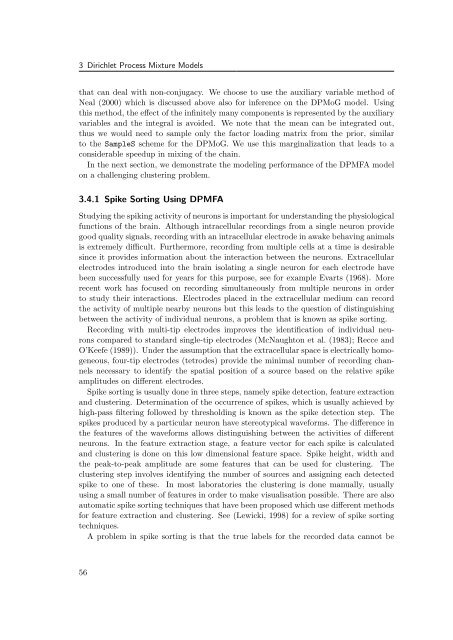Nonparametric Bayesian Discrete Latent Variable Models for ...
Nonparametric Bayesian Discrete Latent Variable Models for ...
Nonparametric Bayesian Discrete Latent Variable Models for ...
Create successful ePaper yourself
Turn your PDF publications into a flip-book with our unique Google optimized e-Paper software.
3 Dirichlet Process Mixture <strong>Models</strong><br />
that can deal with non-conjugacy. We choose to use the auxiliary variable method of<br />
Neal (2000) which is discussed above also <strong>for</strong> inference on the DPMoG model. Using<br />
this method, the effect of the infinitely many components is represented by the auxiliary<br />
variables and the integral is avoided. We note that the mean can be integrated out,<br />
thus we would need to sample only the factor loading matrix from the prior, similar<br />
to the SampleS scheme <strong>for</strong> the DPMoG. We use this marginalization that leads to a<br />
considerable speedup in mixing of the chain.<br />
In the next section, we demonstrate the modeling per<strong>for</strong>mance of the DPMFA model<br />
on a challenging clustering problem.<br />
3.4.1 Spike Sorting Using DPMFA<br />
Studying the spiking activity of neurons is important <strong>for</strong> understanding the physiological<br />
functions of the brain. Although intracellular recordings from a single neuron provide<br />
good quality signals, recording with an intracellular electrode in awake behaving animals<br />
is extremely difficult. Furthermore, recording from multiple cells at a time is desirable<br />
since it provides in<strong>for</strong>mation about the interaction between the neurons. Extracellular<br />
electrodes introduced into the brain isolating a single neuron <strong>for</strong> each electrode have<br />
been successfully used <strong>for</strong> years <strong>for</strong> this purpose, see <strong>for</strong> example Evarts (1968). More<br />
recent work has focused on recording simultaneously from multiple neurons in order<br />
to study their interactions. Electrodes placed in the extracellular medium can record<br />
the activity of multiple nearby neurons but this leads to the question of distinguishing<br />
between the activity of individual neurons, a problem that is known as spike sorting.<br />
Recording with multi-tip electrodes improves the identification of individual neurons<br />
compared to standard single-tip electrodes (McNaughton et al. (1983); Recce and<br />
O’Keefe (1989)). Under the assumption that the extracellular space is electrically homogeneous,<br />
four-tip electrodes (tetrodes) provide the minimal number of recording channels<br />
necessary to identify the spatial position of a source based on the relative spike<br />
amplitudes on different electrodes.<br />
Spike sorting is usually done in three steps, namely spike detection, feature extraction<br />
and clustering. Determination of the occurrence of spikes, which is usually achieved by<br />
high-pass filtering followed by thresholding is known as the spike detection step. The<br />
spikes produced by a particular neuron have stereotypical wave<strong>for</strong>ms. The difference in<br />
the features of the wave<strong>for</strong>ms allows distinguishing between the activities of different<br />
neurons. In the feature extraction stage, a feature vector <strong>for</strong> each spike is calculated<br />
and clustering is done on this low dimensional feature space. Spike height, width and<br />
the peak-to-peak amplitude are some features that can be used <strong>for</strong> clustering. The<br />
clustering step involves identifying the number of sources and assigning each detected<br />
spike to one of these. In most laboratories the clustering is done manually, usually<br />
using a small number of features in order to make visualisation possible. There are also<br />
automatic spike sorting techniques that have been proposed which use different methods<br />
<strong>for</strong> feature extraction and clustering. See (Lewicki, 1998) <strong>for</strong> a review of spike sorting<br />
techniques.<br />
A problem in spike sorting is that the true labels <strong>for</strong> the recorded data cannot be<br />
56
















